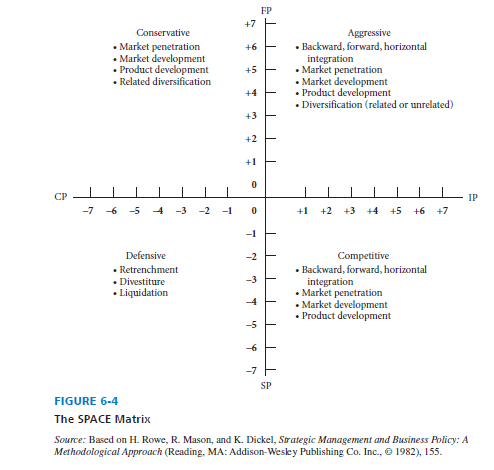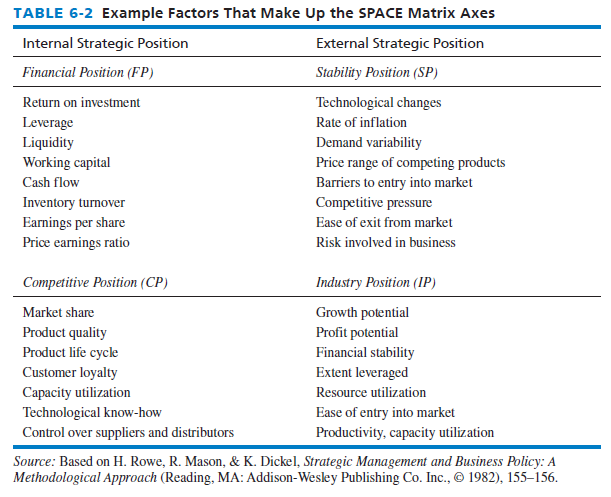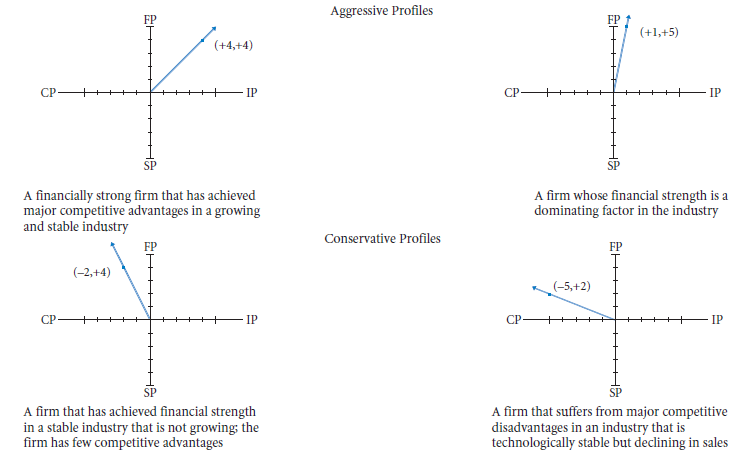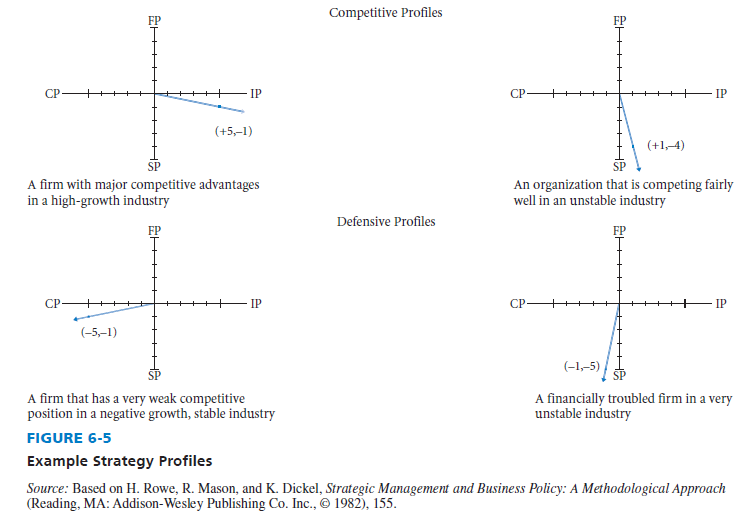The Strategic Position and Action Evaluation (SPACE) Matrix, another important Stage 2 matching tool, is illustrated in Figure 6-4. Its four-quadrant framework indicates whether aggressive, conservative, defensive, or competitive strategies are most appropriate for a given organization. The axes of the SPACE Matrix represent two internal dimensions (financial position [FP] and competitive position [CP]) and two external dimensions (stability position [SP] and industry position [IP]). These four factors are perhaps the most important determinants of an organization’s overall strategic position.5
It is helpful here to elaborate on the difference between the SP and IP axes. The term SP refers to the volatility of profits and revenues for firms in a given industry. Thus, SP volatility (stability) is based on the expected impact of changes in core external factors such as technology, economy, demographic, seasonality, and so on. The higher the frequency and magnitude of changes in a given industry, the more unstable the SP becomes. An industry can be stable or unstable on SP, yet high or low on IP. The smartphone industry, for instance, would be unstable (-6 or -7) on SP yet high growth on IP, whereas the canned food industry would be stable (-1 or -2) on SP yet low growth on IP.
Depending on the type of organization, numerous variables could make up each of the dimensions represented on the axes of the SPACE Matrix. Factors that were included in the firm’s EFE and IFE Matrices should be considered in developing a SPACE Matrix. Other variables commonly included are given in Table 6-2. For example, return on investment, leverage, liquidity, working capital, and cash flow are commonly considered to be determining factors of an organization’s financial position (FP). Like the SWOT Matrix, the SPACE Matrix should be both tailored to the particular organization being studied and based on factual information to the extent possible.

The process of developing a SPACE Matrix can be summarized in six steps, as follows:
- Select a set of variables to define financial position (FP), competitive position (CP), stability position (SP), and industry position (IP).
- Assign a numerical value ranging from +1 (worst) to +7 (best) to each of the variables that make up the FP and IP dimensions. Assign a numerical value ranging from -1 (best) to -7 (worst) to each of the variables that make up the SP and CP dimensions. On the FP and CP axes, make comparisons to competitors. On the IP and SP axes, make comparisons to other industries. On the SP axis, know that a -7 denotes highly unstable industry conditions, whereas -1 denotes highly stable.
- Compute an average score for FP, CP, IP, and SP by summing the values given to the variables of each dimension and then by dividing by the number of variables included in the respective dimension.
- Plot the average scores for FP, IP, SP, and CP on the appropriate axis in the SPACE Matrix.
- Add the two scores on the x-axis and plot the resultant point on Add the two scores on the y-axis and plot the resultant point on Y. Plot the intersection of the new (x, y) coordinate.
- Draw a directional vector from the origin of the SPACE Matrix (0,0) through the new (x, y) coordinate. That vector, being located in a particular quadrant, reveals particular strategies the organization should consider.
Some example strategy profiles that can emerge from SPACE analysis are shown in Figure 6-5 The directional vector associated with each profile suggests the type of strategies to pursue: aggressive, conservative, defensive, or competitive. Specifically, when a firm’s directional vector is located in the Aggressive Quadrant (upper right) of the SPACE Matrix, an organization is in an excellent position to use its internal strengths to (1) take advantage of external opportunities, (2) overcome internal weaknesses, and (3) avoid external threats. Therefore, market penetration, market development, product development, backward integration, forward integration, horizontal integration, or diversification, can be feasible, depending on the specific circumstances that face the firm.

When a particular company is known, the analyst must be much more specific in terms of recommended strategies. For example, instead of saying market penetration is a recommended strategy when your vector is located in the Conservative Quadrant, say that adding 34 new stores in India is a recommended strategy. This is an important point for students doing case analyses because whenever a particular company is known, then terms such as market development are too vague to use. That term could refer to adding a manufacturing plant in Thailand or Mexico or South Africa. Thus, be specific to the extent possible regarding implications of all the matrices presented herein this chapter. Vagueness can be disastrous in strategic management. Avoid terms such as expand, increase, decrease, and grow—be more specific than that! Reveal how your proposed strategies could enable your company to rotate/shift its SPACE vector more toward the Aggressive Quadrant.


The directional vector may appear in the Conservative Quadrant (upper left) of the SPACE Matrix, which implies staying close to the firm’s basic competencies and not taking excessive risks. Conservative strategies most often include market penetration, market development, product development, and related diversification. The directional vector may be located in the Defensive Quadrant (lower left) of the SPACE Matrix, which suggests the firm should focus on improving internal weaknesses and avoiding external threats. Defensive strategies include retrenchment, divestiture, liquidation, and related diversification. Finally, the directional vector may be located in the Competitive Quadrant (lower right) of the SPACE Matrix, indicating competitive strategies. Competitive strategies include backward, forward, and horizontal integration; market penetration; market development; and product development.
Note that a SPACE Matrix has some limitations:
- It is a snapshot in time.
- There are more than four dimensions that firms could/should be rated on.
- The directional vector could fall directly on an axis, or could even go nowhere if the coordinate is (0,0).
- Implications of the exact angle of the vector within a quadrant are unclear.
- The relative attractiveness of alternative strategies generated is unclear.
- Key underlying internal and external factors are not explicitly considered.
A SPACE Matrix for Domino’s Pizza, Inc. is provided in Figure 6-6. Note the SPACE vector for Domino’s is located in the Competitive Quadrant (lower right), based primarily on three factors: (1) the company’s $1.5 billion in long-term debt, (2) intense competition within the fast-food industry, and (3) offering products that are generally not a healthy food choice. Domino’s should consider adding a line of salads to their menu to shift the SPACE vector into the Aggressive Quadrant (upper right); adding salads would likely benefit Domino’s financially, thus moving the SPACE point on the vertical (y-axis) up.

In performing strategic-management case analysis, prepare the SPACE Matrix (and all matrices) based on the point in time of your analysis rather than a desired future point in time. However, in your discussion of implications, be sure to comment on what you recommend the firm should do to improve its situation. Focus more on implications of matrices than on “number crunching” in your actual oral delivery of a case analysis.
Source: David Fred, David Forest (2016), Strategic Management: A Competitive Advantage Approach, Concepts and Cases, Pearson (16th Edition).

Hello i want to know why its written that dominos lie in competitive quadrant as it is clearly in defensive quadrant…?? Please explain it thank you
I gotta favorite this website it seems very beneficial invaluable